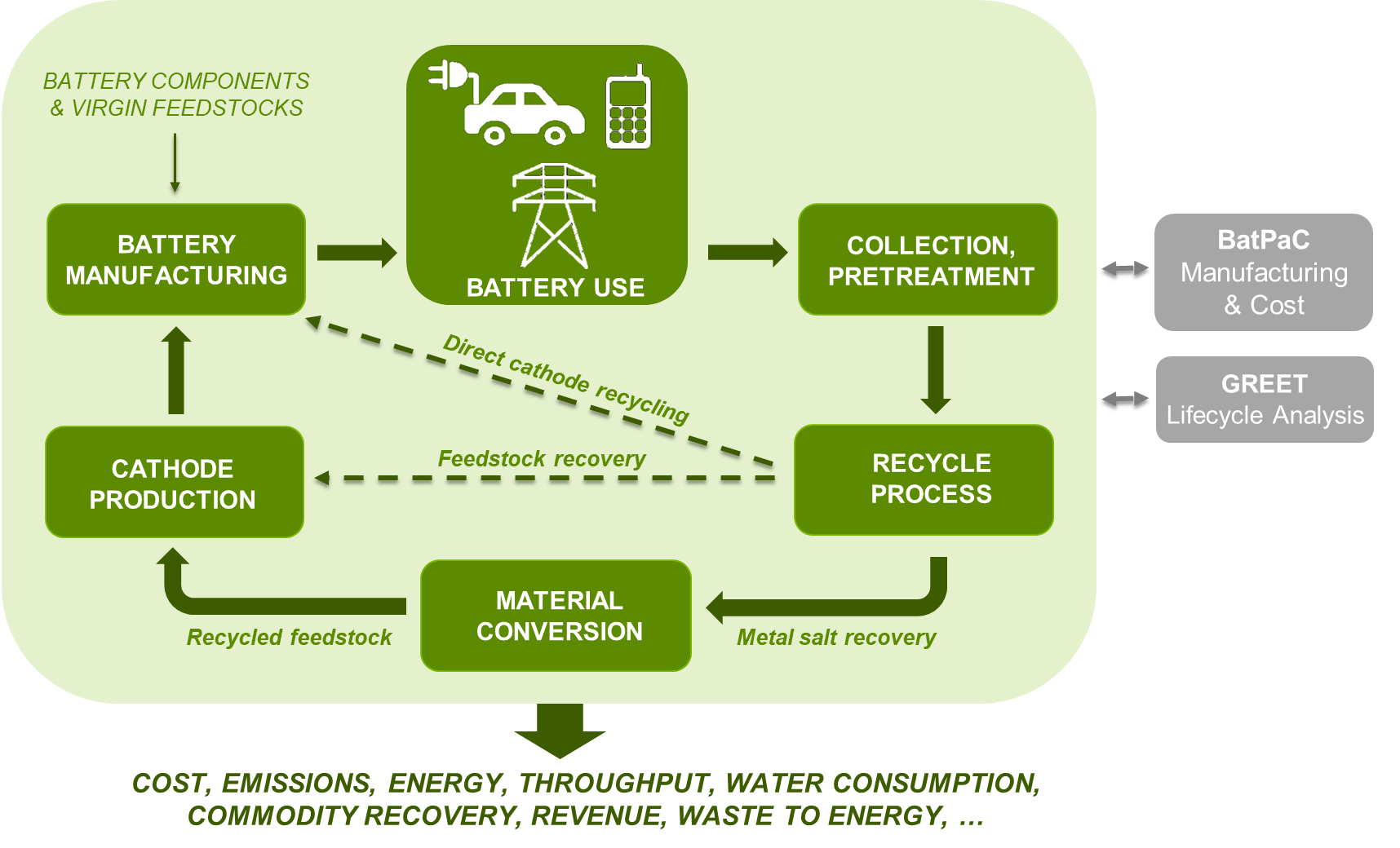Battery Material Supply
From Minerals to Materials
Argonne is working to address the urgent need to create a domestic supply chain for energy storage materials while creating both immediate and long-term domestic jobs. The U.S. does not currently produce, nor manufacture, much of our energy storage materials, and rely on other countries for these products. This has been likened to the vulnerability of the U.S. on oil supply in the past.
To address this need, Argonne is taking a holistic approach that is necessary to build up a domestic supply chain. This approach recognizes that both upstream and midstream processing, as well as recycling feedstocks, are needed to establish the complete system needed to realize a truly domestic-centric battery material supply chain. To do this, new technologies are being explored that provide opportunity to produce materials from our own resources. New technologies are also explored and tested here at Argonne that will convert those minerals into the materials that are needed to make batteries locally. Likewise, we are working to close the supply loop from domestically recycled batteries.
This effort is closely linked to the Materials Engineering Research Facility (MERF) and the manufacturing initiative at Argonne. The MERF is a facility that optimizes and scales up new manufacturing processes which naturally lends itself to tackling the challenges and opportunities before us. ReCell is also closely linked to the supply chain effort and remains in close collaboration.
A thorough understanding of the supply chain is needed, thus Argonne’s Global Critical Materials Model is being is utilized. Other models included in this effort include EverBatt, a cost and environmental impact calculation tool, and Argonne’s Model for Universal Solvent Extraction (AMUSE) which is used to efficiently determine the best methods for critical materials separation.
Perhaps most importantly, relationships with industry and research partners are critical from turning new technology into commercially recognized operations. Argonne has created close relations with many of the supply chain stakeholders and looks forward to creating new relationships. We are always seeking new collaborations.
Recycling
Ensuring Cost Effective Battery Recycling
Argonne has a strong recycling history and that is no different when it comes to battery recycling. Argonne’s leadership in both the development of material recycling technologies along with the development of new, advanced technologies has led to the perfect marriage of expertise in addressing the entire life-cycle processing needs of advanced battery chemistries.
Argonne leads the ReCell Center which includes the National Renewable Energy Laboratory and Oak Ridge National Laboratory, as well as several universities. Argonne hosts the center’s several research and demonstration laboratories that range from bench- to pilot- to full-scale equipment.
Argonne addresses battery recycling similarly to the other material recycling challenges it addresses. The key is to use and develop technologies that make recycling cost effective in the U.S. while still taking advantage of recycling’s environmental and energy benefits. When a product or material has value at the end of its life recycling will happen automatically. Without value, there is not much incentive to drive circularity and all the good things that come from it.
To realize this philosophy, Argonne uses its unique set of tools to understand the fundamentals of how batteries and their recycling technologies work, and then applies that in the laboratories to advance the separation and recycling technologies. Argonne works closely with industry to make sure the real challenges are identified and to ensure our methods will be adopted by industry. ReCell has included industry in its journey from day one and will continue to build those relationships moving forward.
EverBatt
Life-cycle Analysis
Argonne has a long track record of R&D expertise with lithium-ion batteries, and now has a powerful computer model that analyzes quantitatively every step within the battery life-cycle, from manufacturing to recycling.
Lithium-ion batteries are complex technologies. Because new designs and materials are springing up at a dizzying pace, planning for future recovery of used battery materials is a serious challenge. Several recycling processes have been proposed or are operating, and each has advantages and disadvantages.
The Argonne-developed R&D 100 winning model called “EverBatt” allows battery manufacturers, recyclers, and processors throughout the life-cycle to determine the cost and environmental impacts at each stage of the batteries life. This new concept model breaks down each process from its manufacture to its being recycled into a new battery. EverBatt leverages Argonne’s previously developed Greenhouse Gases, Regulated Emissions, and Energy Use in Transportation (GREET) model and its Battery Performance and Cost (BatPaC) model.
BatPaC captures the interplay between design and cost of lithium-ion batteries for transportation applications. GREET evaluates the material use and process inputs to provide energy and emission impacts at the various stages of a battery’s life.
EverBatt is a model that:
- Provides insight into the relative impacts of different recycling paths.
- Accelerates research by guiding it toward processes with minimum economic, energy, and environmental impacts.
- Allows stakeholders to visualize the big life-cycle picture.
Information provided by EverBatt will become increasingly important as millions of batteries from vehicles sold over the last decade reach their end of life. By 2025, for example, annual sales of plug-in electric vehicles are projected to exceed 1.2 million vehicles, more than 7 percent of annual vehicle sales.
Argonne is using EverBatt and other models to identify the greenest, most economical recycling processes, determine how much of which materials could be recovered with current or improved recycling methods, and quantifying the environmental impacts of both battery production and recycling processes through life-cycle analyses.
